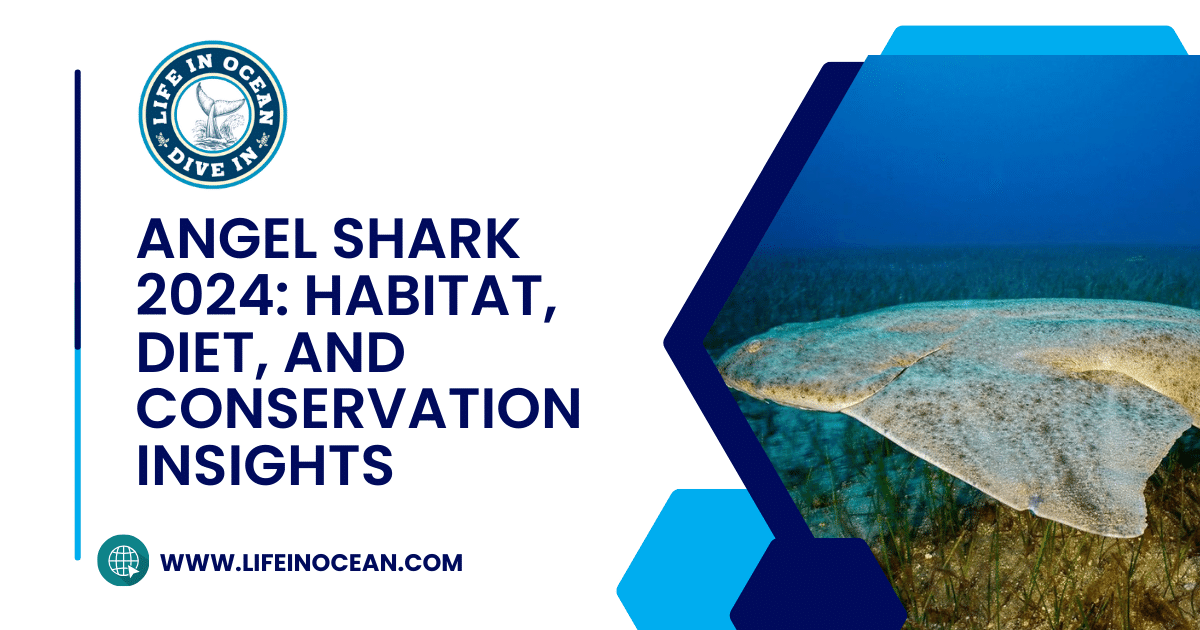Angel sharks, often referred to as “flat sharks,” are a unique species of shark known for their flattened bodies, wide pectoral fins, and gill slits. As members of the Pacific angel shark family, these creatures have earned their name due to their distinct appearance. Their flat bodies allow them to seamlessly blend into sandy or muddy environments, making them skilled ambush predators. Efforts are underway to conserve and protect these fascinating creatures despite being on the list of endangered species.
Table of Contents
Intriguing Nature of Angel Shark Species
Camouflage
Angel sharks possess a remarkable ability to camouflage themselves on the ocean floor. Their bodies, with their unique stronghold and size, blend seamlessly into the sandy or muddy bottoms where they reside. This exceptional adaptation allows flat sharks to remain virtually invisible to unsuspecting prey such as fish and crustaceans.
These angel shark species, resembling rays due to their flattened bodies, are masters of disguise. Their flat bodies, coupled with an intricate pattern of coloration and markings, help the Atlantic angel shark effectively conceal themselves against the backdrop of the ocean floor. As a result, they can patiently await their next meal without alerting potential victims.
Ambush Predators
When it comes time to hunt for food, angel sharks display their prowess as ambush predators. They lie in wait for passing prey using their well-adapted camouflage technique before launching a surprise attack from below. With powerful jaws and sharp teeth perfectly suited for catching smaller marine creatures by surprise, angel sharks rely on stealth rather than speed when capturing meals.
Their hunting strategy is reminiscent of that employed by other ambush predators like monkfish — another fascinating predator that shares similar hunting tactics with angel sharks.
Unique Breathing Method
One distinctive feature possessed by these captivating creatures is their method of breathing through specialized structures known as spiracles. Located behind each eye, spiracles enable angel sharks to draw in oxygenated water while resting motionless on the seafloor. This adaptation allows them to maintain a low profile while conserving energy until an opportunity arises for an ambush attack.
Angel Shark Appearance and Biology
Ray-Like Appearance
Angel sharks have a unique appearance that sets them apart from other shark species. Their flattened bodies and broad pectoral fins make them look more like rays than typical sharks. This physical characteristic allows them to easily blend in with the ocean floor, providing effective camouflage as they wait for their prey.
These sharks possess a distinctive feature known as ampullae of Lorenzini. These specialized sensory organs are found in cartilaginous fish, including angel sharks. They help the shark detect electric fields produced by potential prey, aiding in their hunting abilities.
Camouflage Coloration
The coloration of African angel sharks is another fascinating aspect of their biology. Their skin patterns and colors allow them to seamlessly blend into their surroundings on the seafloor, making it easier for them to ambush unsuspecting prey. This adaptive camouflage helps protect angel sharks from predators while also enhancing their hunting success.
Angel Shark Habitat and Geographic Range
Coastal Areas
Angel sharks are commonly found in various coastal areas around the world, including the Australian angelshark. They prefer to inhabit sandy or muddy bottoms, especially in shallow waters close to the shore. This specific habitat preference allows them to camouflage effectively on the seafloor, making it easier for them to ambush their prey.
Angel sharks’ unique adaptation makes them well-suited for life along the coast. Their flattened bodies and wing-like pectoral fins enable the Atlantic angel shark to blend seamlessly into their surroundings, resembling a patch of sand as they lie in wait for unsuspecting fish or crustaceans.
Geographic Range
The geographic range of angel sharks spans across a wide area, from the Mediterranean Sea to the Pacific Ocean. This extensive distribution highlights their adaptability and ability to thrive in diverse marine environments.
Their presence in these different regions also underscores their importance as an indicator species for monitoring ecosystem health and biodiversity within these vast marine ecosystems.
Diet and Hunting Behavior of Angel Sharks

Nocturnal Hunters
Angel sharks are nocturnal hunters, meaning they actively seek food at night. This behavior sets them apart from other sharks that primarily hunt during the day. Due to their nocturnal nature, angel sharks have adapted to low-light conditions, making it easier for them to surprise their prey.
Angel sharks rely on their exceptional camouflage to blend into the ocean floor as they patiently wait for unsuspecting prey to swim by. Their ability to remain virtually undetected allows them to ambush bony fish, crustaceans, and mollusks with ease.
Varied Diet
The diet of angel sharks consists mainly of bony fish, such as flatfish and small sharks, along with a variety of crustaceans like crabs and shrimp. They also consume various types of mollusks, including squid and octopus. Their diverse diet, including angel shark eating, showcases their adaptability in hunting different types of marine life within their habitat.
Threats Facing Angel Sharks in the Wild
Overfishing
Angel sharks face a significant threat from overfishing, which has led to a decline in their populations. This occurs when too many angel sharks are caught, disrupting the balance of their ecosystem and endangering the species. For example, some shark populations have decreased by more than 90% due to overfishing.
Overfishing disrupts the angel shark’s role as an important predator in marine ecosystems. As a result, it can lead to imbalances within food chains and negatively impact other marine life that depend on angel sharks for regulation.
Destruction of Natural Habitat
The destruction of natural habitats due to human activities is another major concern for angel sharks. Human actions such as coastal development, pollution, and habitat degradation directly impact the areas where angel sharks live and reproduce. For instance, construction near coastlines can destroy crucial breeding grounds for these sharks.
Habitat destruction affects not only angel shark populations but also the entire marine ecosystem they inhabit. It disrupts their ability to find suitable prey and shelter while also impacting their reproductive success.
Bycatch in Commercial Fishing Operations
Bycatch in commercial fishing operations poses a serious threat to angelsharks. When fishing vessels catch unintended species like angelsharks while targeting other fish, it can significantly harm these shark populations. This unintentional capture often leads to injury or death for many angelsharks.
Bycatch threatens not only individual angelshark survival but also contributes to overall population declines among this critically endangered species.
Global Efforts in Angel Shark Conservation
Protected Areas
Various organizations are working to establish protected areas for angelsharks. These areas serve as safe havens where angel sharks can thrive without the threat of human interference. By designating these regions, conservationists aim to safeguard the habitats crucial for the survival of angel sharks.
Conservation initiatives focus on research and monitoring of angelshark populations. Scientists and researchers gather data on angel shark behavior, population trends, and habitat use to better understand their needs and vulnerabilities. This information guides conservation efforts by providing insights into how best to protect these unique creatures.
Raising Awareness
Collaborative efforts aim to raise awareness about the plight of angel sharks. Through partnerships with governments, NGOs, and local communities, organizations work together to educate people about the importance of protecting angel sharks. They utilize various channels such as social media campaigns, educational programs, and community engagement activities to reach a wider audience.
Importance of Protecting Angel Sharks
Crucial Role
Angel sharks play a crucial role in maintaining marine ecosystem balance. They are known as “ecosystem engineers” because they impact the environment around them. For instance, angelsharks help regulate the population of their prey, such as fish and crustaceans.
Preserving angelshark populations contributes to overall biodiversity conservation. By protecting these unique creatures, we can ensure that various species within their habitat continue to thrive. This not only benefits the angel sharks but also supports the sustainability of other marine life forms.
Marine Food Webs
Protecting angel sharks helps sustain the health of marine food webs. These apex predators control the abundance and behavior of organisms at lower trophic levels, preventing the overpopulation of certain species and maintaining a balanced ecosystem. For example, if angelshark populations decline due to overfishing or habitat destruction, it can lead to an imbalance in the food web with potential cascading effects on other species.

- Preserves ecosystem balance
- Contributes to overall biodiversity conservation
- Sustains marine food webs
Conclusion on the Plight of Angel Sharks
Conservation Status
The angelshark faces a critical situation, underscoring the urgency for action. Due to factors like overfishing and habitat degradation, angelshark populations have declined significantly. These creatures are now classified as critically endangered, highlighting the pressing need for conservation efforts.

Efforts are essential Continued efforts are crucial to safeguard these remarkable creatures for future generations. Without intervention, the decline of angel sharks could have devastating consequences on marine ecosystems. It is imperative to implement protective measures and promote sustainable fishing practices to ensure the survival of angelsharks.
Individual Contribution
Each individual can contribute to angel shark conservation through education and support for protective measures. Raising awareness about the plight of angel sharks can lead to greater public support for conservation initiatives. Advocating for policies that reduce bycatch and protect shark habitats can make a significant impact.
- Increased public awareness
- Support for protective measures
- Advocacy for policies to reduce bycatch
Frequently Asked Questions
What is the habitat of angel sharks?
Angelsharks are primarily found in sandy or muddy coastal habitats, at depths ranging from 10 to 150 meters. They favor areas with good water circulation and access to prey species, angel shark diet.
How do angel sharks hunt for their food?
Angel sharks are ambush predators that rely on camouflage and stealth to capture their prey. They patiently lie in wait on the seafloor before lunging at passing fish or crustaceans, using their powerful jaws to secure a meal.
Why are angel sharks facing threats in the wild?
The primary threats to angelsharks include overfishing, bycatch in fisheries targeting other species, habitat degradation due to coastal development, and pollution. These factors have significantly impacted their populations worldwide.
What conservation efforts are being made for angel shark protection?
Global efforts for angel shark conservation include establishing marine protected areas, implementing fishing regulations and sustainable practices, conducting research on population dynamics and behavior, as well as raising awareness through educational programs and outreach initiatives.
Why is it important to protect angel sharks?
Protecting angel sharks, including the Australian angelshark, pacific angelshark, and African angel shark, is crucial for maintaining healthy marine ecosystems. As an apex predator, they play a vital role in regulating prey populations and contributing to overall biodiversity. Preserving these species also supports ecotourism activities while safeguarding the cultural heritage associated with them.







